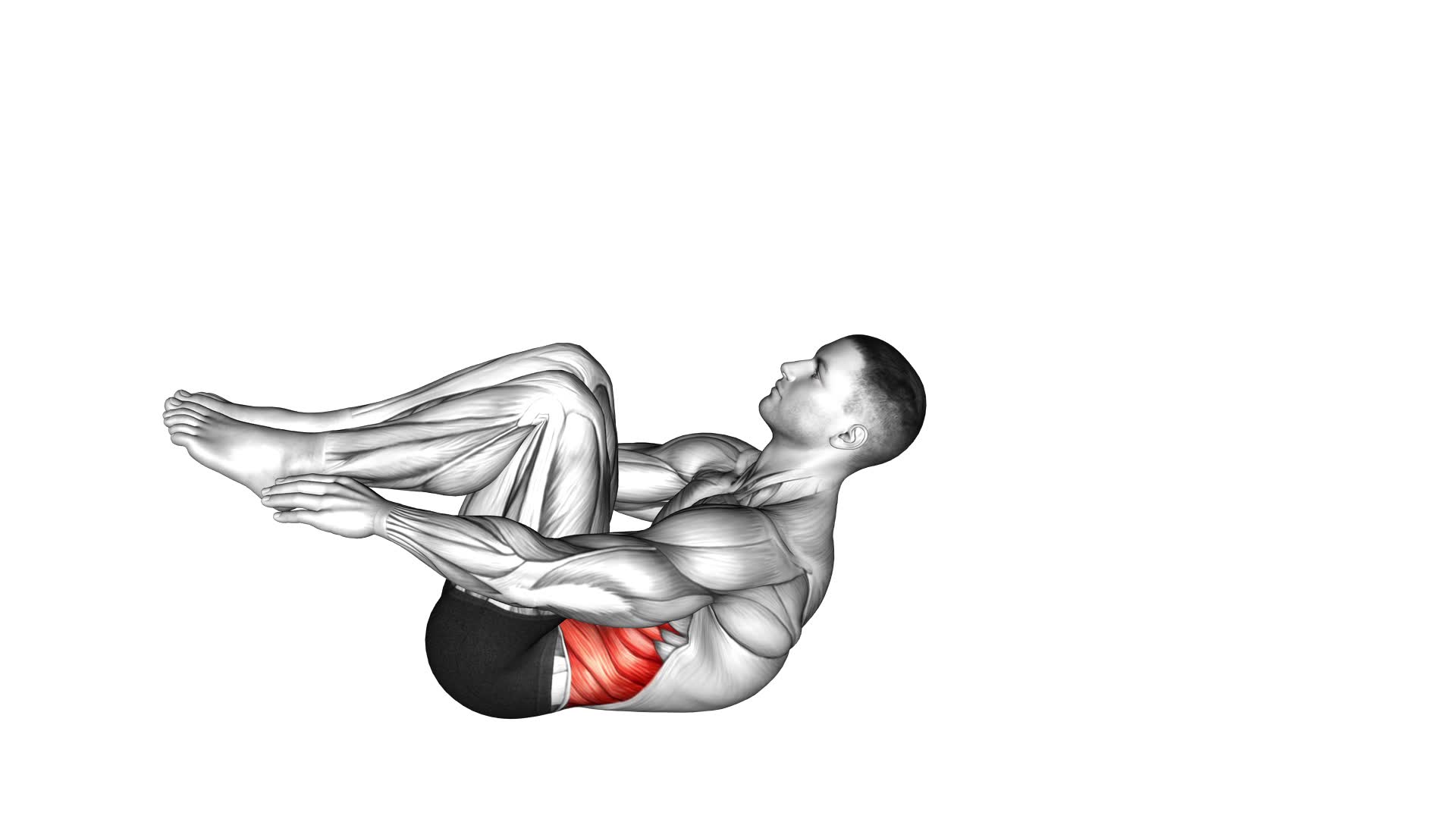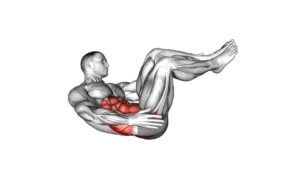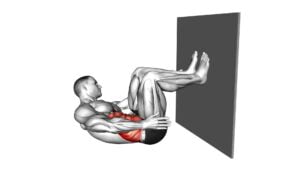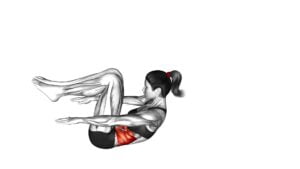90 Degree Heel Touch – Video Exercise Guide & Tips

Are you looking for an effective exercise to strengthen your abs and obliques? Look no further than the 90 Degree Heel Touch!
Watch This Exercise Video
This exercise targets your core muscles while also improving your balance and stability. In this video exercise guide, we will show you the proper form and technique, common mistakes to avoid, and modifications to make it more challenging.
Get ready to feel the burn and take your core strength to the next level!
Key Takeaways
- The 90 Degree Heel Touch targets core muscles, obliques, rectus abdominis, and hip flexors.
- Proper form and technique include maintaining a strong core, avoiding twisting the torso too much, and keeping hips and shoulders square to the ground.
- Common mistakes to avoid include rushing through the movement, using momentum instead of engaging targeted muscles, and not touching the heel at a 90-degree angle.
- Injury prevention tips include warming up, strengthening core and supporting muscles, starting with lighter weights, and maintaining proper form and technique.
Benefits of the 90 Degree Heel Touch
The 90 Degree Heel Touch exercise offers several benefits for improving core strength and flexibility. This exercise primarily targets the oblique muscles, which are located on the sides of your abdomen. By engaging these muscles, the 90 Degree Heel Touch helps to tone and strengthen your core, leading to improved stability and balance. Additionally, this exercise also targets the rectus abdominis, commonly known as the 'six-pack' muscles, as well as the hip flexors.
To perform the 90 Degree Heel Touch, lie on your back with your knees bent at a 90-degree angle and your feet flat on the floor. Place your hands behind your head, keeping your elbows out to the sides. Engage your core and lift your head, neck, and shoulders off the ground. Twist your upper body to one side and reach your opposite hand towards your heel. Return to the starting position and repeat on the other side.
To add variation to the 90 Degree Heel Touch, you can incorporate a medicine ball, dumbbells, or resistance bands. These tools can increase the intensity of the exercise and provide an additional challenge for your core muscles. Remember to maintain proper form and engage your core throughout the entire movement for optimal results.
Proper Form and Technique
To ensure proper form and technique during the 90 Degree Heel Touch exercise, it's important that you maintain a strong core and engage your oblique muscles throughout the movement. This will help you maximize the effectiveness of the exercise and reduce the risk of injury.
One common error to avoid is twisting your torso too much. It's important to keep your hips and shoulders square to the ground and only rotate your torso as far as you can without straining your lower back. Another common mistake is lifting your head off the ground. Keep your neck relaxed and your gaze focused on a fixed point on the ceiling to maintain proper alignment.
To perform the 90 Degree Heel Touch exercise with proper form, start by lying on your back with your knees bent and feet flat on the ground. Engage your core and lift your shoulders off the ground, reaching your hands towards your heels. As you reach towards your heels, focus on contracting your oblique muscles on the side you're reaching towards.
To help you maintain proper form and technique, here are some effective cues: keep your core engaged throughout the exercise, breathe steadily, and avoid any jerking or swinging motions. Remember to go at your own pace and listen to your body.
With consistent practice and attention to form, you'll be able to perform the 90 Degree Heel Touch exercise with precision and achieve your fitness goals.
Common Mistakes to Avoid
To ensure proper form during the degree heel touch exercise, there are a few essential points to keep in mind.
Firstly, maintain a strong core and engage the abdominal muscles throughout the movement.
Secondly, avoid using momentum or swinging the legs, as this can decrease the effectiveness of the exercise and increase the risk of injury.
Lastly, focus on controlled and deliberate movements, ensuring that the heel touches the ground at a 90-degree angle.
Proper Form Essentials
What are the common mistakes you should avoid when performing the Degree Heel Touch exercise?
Proper form is essential to maximize the benefits of this exercise and prevent injuries. One common mistake is rushing through the movement, sacrificing proper technique for speed. This can lead to improper alignment and strain on the lower back.
Another mistake is using momentum instead of engaging the targeted muscles. This can result in a less effective workout and potential muscle imbalances.
Additionally, avoid rounding your back or hunching your shoulders, as this can put unnecessary stress on the spine.
By maintaining proper form and technique, you can minimize the risk of injury and optimize your results.
Now let's move on to some injury prevention tips.
Injury Prevention Tips
Ensure proper form and technique to prevent injuries while performing the Degree Heel Touch exercise.
Injury prevention is crucial to maintaining a safe and effective workout routine. Before starting any exercise, it's essential to warm up your body with dynamic stretching or light cardio exercises. This helps increase blood flow to the muscles and prepares them for the upcoming workout.
Additionally, incorporating strengthening exercises for the muscles involved in the Degree Heel Touch can help prevent injuries. By strengthening the core, glutes, and legs, you provide better support and stability to your body during the exercise.
Remember to start with lighter weights and gradually increase the intensity to avoid straining your muscles.
Modifications and Progressions
Make modifications and progressions to the degree heel touch exercise to challenge yourself and continue to improve your strength and coordination. There are several modification variations you can try to increase the difficulty of this exercise.
One option is to use a stability ball instead of keeping your feet on the ground. Place your feet on top of the ball and perform the heel touches from this unstable surface. This will engage more muscles in your core and challenge your balance.
Another modification is to increase the range of motion by reaching your hand further away from your body or by touching your heel with your fingertips instead of your hand.
For those looking for advanced variations, you can add weights to the exercise. Hold a dumbbell or kettlebell in your hand as you perform the heel touches. This will provide an additional challenge for your muscles and increase the intensity of the exercise.
Another advanced variation is to perform the exercise on an unstable surface, such as a balance board or a Bosu ball. This will require even more stability and coordination, further enhancing the effectiveness of the exercise.
Remember to always listen to your body and progress at a pace that's comfortable for you. It's important to maintain proper form and technique throughout the exercise to prevent any injuries. By making modifications and progressing with advanced variations, you can continue to challenge yourself and make progress in your strength and coordination.
Recommended Sets and Reps
When it comes to the recommended sets and reps for the Degree Heel Touch exercise, there are a few key points to consider.
First, finding the optimal training volume is important to ensure you're challenging your muscles without overdoing it.
Next, progression strategies should be implemented gradually to continue seeing improvements in strength and endurance.
Lastly, don't forget the importance of rest and recovery between sets and workouts to allow your muscles to repair and grow.
Optimal Training Volume
To maximize your results, it's important to determine the optimal training volume for your degree heel touch exercise. This refers to the number of sets and repetitions you should perform during each training session. Finding the right training volume depends on various factors such as your training frequency and exercise variations. Here are some guidelines to help you determine the optimal training volume for your degree heel touch exercise:
- Start with 2-3 sets: Begin by performing 2-3 sets of the degree heel touch exercise.
- Gradually increase repetitions: Start with 8-10 repetitions per set and gradually increase as your strength and endurance improve.
- Listen to your body: Pay attention to how your body responds to the exercise and adjust the volume accordingly.
- Vary the intensity: Incorporate variations like adding weights or increasing the range of motion to challenge your muscles.
- Seek professional guidance: If you're unsure about the optimal training volume, consult a fitness professional for personalized recommendations.
Progression Strategies
To progress your degree heel touch exercise, it's recommended to gradually increase the number of sets and repetitions you perform. Progression techniques are essential to continually challenge your muscles and improve your training intensity.
As you become comfortable with the exercise, you can start by adding an extra set or two to your routine. Aim to increase the number of repetitions you perform within each set as well. For example, you can start with 2 sets of 10 repetitions, and then gradually increase to 3 sets of 12 repetitions. This gradual increase in sets and reps will help to improve your strength and endurance over time.
As we move into the next section about rest and recovery, it's important to remember that allowing your muscles time to recover is crucial for optimal progress and preventing injury.
Rest and Recovery
To optimize your progress and prevent injury, it's important to incorporate adequate rest and recovery into your training routine. Here are some recommended rest and recovery techniques to help you recover effectively:
- Take regular rest days: Give your body time to recover and rebuild after intense workouts.
- Get enough sleep: Aim for 7-9 hours of quality sleep each night to promote muscle repair and growth.
- Practice relaxation techniques: Try deep breathing, meditation, or yoga to reduce stress and promote overall relaxation.
- Use foam rollers or massage tools: These can help release tension in your muscles and improve circulation.
- Stay hydrated: Proper hydration is essential for muscle recovery and overall performance.
Safety Precautions and Tips
When performing the Degree Heel Touch exercise, it's important to prioritize safety by following these tips and precautions.
First and foremost, always warm up properly before engaging in any exercise routine. This helps to prepare your muscles and joints for the workout, reducing the risk of injury.
Additionally, it's crucial to maintain proper form throughout the exercise. Keep your back straight, engage your core, and avoid any excessive twisting or jerking movements. This will help to protect your spine and prevent strain on your muscles.
Another safety tip is to start with lighter weights and gradually increase the intensity as you become more comfortable and confident with the exercise. This allows your body to adapt and build strength gradually, reducing the risk of overexertion or muscle strain.
Finally, listen to your body. If you experience any pain or discomfort while performing the Degree Heel Touch, stop immediately and consult with a healthcare professional.
Frequently Asked Questions
Can the 90 Degree Heel Touch Exercise Help With Improving Balance and Stability?
Improving balance and stability is crucial for your overall fitness. One exercise that can help is the 90 degree heel touch.
By incorporating this exercise into your routine, you can challenge your core muscles and improve your balance. It's important to maintain proper form throughout the exercise to maximize its benefits.
Engaging your core and focusing on your balance will enhance the effectiveness of this exercise in improving your stability.
Is the 90 Degree Heel Touch Exercise Suitable for Beginners or Should It Be Done by More Advanced Individuals?
The 90 degree heel touch exercise can be suitable for both beginners and more advanced individuals. It's a great exercise for improving balance and stability, regardless of your fitness level.
Beginners can start by performing the exercise with a smaller range of motion and gradually increase it as they become more comfortable and confident.
Advanced individuals can challenge themselves by adding weights or performing the exercise on an unstable surface.
Remember to always listen to your body and adjust the intensity accordingly.
What Muscles Are Primarily Targeted and Strengthened During the 90 Degree Heel Touch Exercise?
During the 90 degree heel touch exercise, several muscles are primarily targeted and strengthened.
The exact muscles depend on your form and technique. However, common muscles activated include the obliques, rectus abdominis, and hip flexors.
To ensure proper form and maximize muscle activation, it's important to keep your core engaged, maintain a neutral spine, and avoid excessive twisting.
Focus on controlled movements and avoid using momentum to achieve the best results.
Can the 90 Degree Heel Touch Exercise Help With Reducing Lower Back Pain?
The 90 degree heel touch exercise can be beneficial for reducing lower back pain and improving balance and stability. By targeting the muscles in the core and lower body, this exercise helps to strengthen the muscles that support the spine.
This increased strength and stability can help alleviate pressure on the lower back, leading to a reduction in pain. Additionally, the exercise also improves balance, which can further contribute to a healthier back and overall well-being.
How Often Should the 90 Degree Heel Touch Exercise Be Performed for Optimal Results?
To get optimal results from the 90 degree heel touch exercise, it's important to know how often to perform it.
The frequency of this exercise depends on your fitness level and goals. Beginners should start with 2-3 times per week and gradually increase the frequency as they get stronger.
It's also important to listen to your body and make modifications if needed. Consulting with a fitness professional can help you determine the optimal frequency for your individual needs.
Conclusion
Incorporating the 90 Degree Heel Touch into your exercise routine can provide numerous benefits, including improved core strength and stability.
By maintaining proper form and technique, you can maximize the effectiveness of this exercise. Avoid common mistakes such as lifting your head or shoulders off the ground.
Modifications and progressions can be made to suit your fitness level.
Remember to always prioritize safety and consult with a professional before attempting any new exercise.

Author
Years ago, the spark of my life’s passion ignited in my mind the moment I stepped into the local gym for the first time. The inaugural bead of perspiration, the initial endeavor, the very first surge of endorphins, and a sense of pride that washed over me post-workout marked the beginning of my deep-seated interest in strength sports, fitness, and sports nutrition. This very curiosity blossomed rapidly into a profound fascination, propelling me to earn a Master’s degree in Physical Education from the Academy of Physical Education in Krakow, followed by a Sports Manager diploma from the Jagiellonian University. My journey of growth led me to gain more specialized qualifications, such as being a certified personal trainer with a focus on sports dietetics, a lifeguard, and an instructor for wellness and corrective gymnastics. Theoretical knowledge paired seamlessly with practical experience, reinforcing my belief that the transformation of individuals under my guidance was also a reflection of my personal growth. This belief holds true even today. Each day, I strive to push the boundaries and explore new realms. These realms gently elevate me to greater heights. The unique combination of passion for my field and the continuous quest for growth fuels my drive to break new ground.







